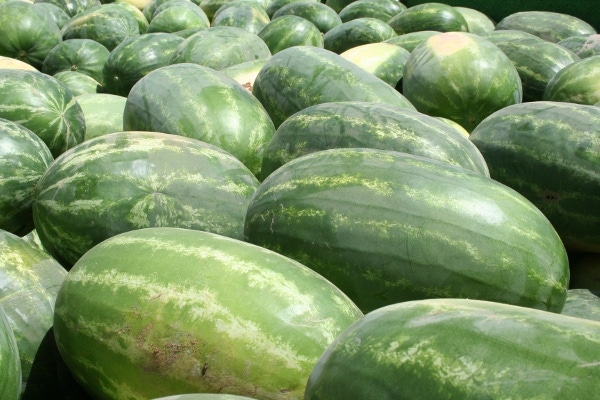
Whitefly numbers on fall melons are very high in Arizona’s Yuma Valley due largely to the crop landscape where melon fields are near or adjacent to cotton and alfalfa.The Arizona winter lettuce season includes the threat of diseases caused by soil-borne fungal pathogens.Dinitroanaline herbicides kill weeds pre-emergence by inhibiting cell division and elongation at the growing points of seedling roots.
September 12, 2011

The latest Arizona Vegetable Integrated Pest Management Update from the University of Arizona (UA) Cooperative Extension in Yuma, Ariz., released Sept. 7, 2011.
Whitefly management on fall vegetables and melons
By John Palumbo, UA Research Scientist and Extension Specialist
Whitefly numbers on fall melons have been very high in the Yuma Valley, and extremely high (>100/leaf) in some areas of the Dome Valley, Wellton, and further east. This high whitefly abundance is attributed largely to the crop landscape where melon fields are near or adjacent to cotton and alfalfa.
During the week of Aug. 29, high numbers (clouds) of whitefly adults were seen in Dome Valley reminiscent to the early 1990s.
Since whiteflies were quite damaging last fall in produce and melon crops, pest control advisers would be wise to pay particular attention to early whitefly control and discuss control strategies with growers.
Remember, the key to effective whitefly management in fall crops is to prevent adult and immature populations from colonizing small plants.
Prolonged feeding by adults on melons can rapidly spread virus throughout the field. On seedling lettuce plants, prolonged adult feeding can result in stunted growth.
Allowing adults to remain on plants unchecked generally results in the development of large nymph populations which can cause significant growth/yield reductions in all produce and melon crops.
With the high numbers this year, it is strongly recommended that growers apply a soil neonicotinoid on lettuce and cole crops in September and early October.
Local research has shown that imidacloprid (e.g., Alias-16 oz, or Admire Pro- 7 oz ; [0.25 lbs AI/ac]) applied at planting provides less residual control of nymphs today than it did 10 years ago. Although the insecticide still provides short-term control (21-28 days), growers should consider using higher rates of imidacloprid (e.g., Alias-24 oz, or Admire Pro- 10.4 oz [0.375 lb AI/ac]) to extend residual control.
Once plants get larger, products including Movento, Venom, Scorpion, Assail, Knack, and Courier can provide effective control of nymphs.
For adult control, combinations of bifenthrin (e.g. Brigade, Sniper, Discipline, etc.) or Danitol tank-mixed with Thionex will provide the best residual control.
Other options that can be tank-mixed with pyrethroids for knockdown control include Vydate, Orthene, Lannate, Lorsban, Dibrom, Venom, Scorpion, and Assail.
For more information on whitefly biology, management, and insecticide alternatives, review these links: Insect Management on Desert Vegetables and Melons: Whiteflies and the Whitefly Control Chart.
Contact Palumbo: (928) 782-3836 or [email protected].
Soil-borne lettuce pathogens
Soil-borne lettuce pathogens
By Mike Matheron, UA Extension Plant Pathologist
With the beginning of another lettuce growing season in Arizona comes the threat of diseases caused by soil-borne fungal pathogens. Diseases of concern for lettuce now being planted include Fusarium wilt, Sclerotinia drop, and bottom rot.
Symptoms of Fusarium wilt, caused by Fusarium oxysporum f. sp.lactucae, can appear on lettuce anytime after thinning. There are no effective fungicides to manage Fusarium wilt.
This disease is best avoided by not planting susceptible types of lettuce (virtually all head lettuce varieties) in ground known to contain the pathogen, especially during September and October.
Soil temperatures during these months favor the growth of Fusarium oxysporum and the resulting development of the wilt disease.
Sclerotinia drop and bottom rot usually do not become apparent in fields until plants are at or past the rosette stage of development.
Successful management of Sclerotinia drop, caused almost exclusively by Sclerotinia minor on lettuce that will be harvested in November and December, as well as bottom rot caused by Rhizoctonia solani, require application of fungicides well before the appearance of disease symptoms. Sclerotinia minor and Rhizoctonia solani exist in soil as resistant structures called sclerotia.
Successful management of diseases caused by these pathogens is closely tied to prevention of germination of the sclerotia. Applications of fungicides are made to the soil where the sclerotia are found.
Early application of fungicides, when plants are very small, facilitates thorough coverage of the bed surface. As plants develop and cover increasing amounts of the bed surface, fungicide coverage of soil and disease control declines.
Contact Matheron: (928) 726-6856 or [email protected].
Dinitroanaline herbicides
Dinitroanaline herbicides
By Barry Tickes, UA Area Agriculture Agent
The dinitroanaline herbicides are some of the oldest and most widely used. Sometimes called the “yellow herbicides,” these include Benefin (Balan), Trifluralin (Treflan), Pendimethalin (Prowl), Ethafluralin (Curbit), and Oryzalin (Surflan).
These herbicides kill weeds pre-emergence by inhibiting cell division (mitosis) and elongation at the growing points of seedling roots. The symptoms are “clubbed” or swollen root tips and the lack of lateral root development.
Although these all use the same mode of action and have similar chemical structures, you cannot assume that they all behave the same in the field or have the same effects on the diverse vegetable crops grown in the Yuma area.
Prowl (Pendimethalin) can be used on artichokes, carrots, tomatoes, peppers, and onions but not on lettuce or cole crops. Balan (Benefin) can only be used on lettuce.
Treflan (Trifluralin) can be used on cole crops, carrots, peppers, mustard greens, established asparagus, celery, chicory, established cucurbits, kale, okra, established onions, potatoes, radishes, and tomatoes but not on lettuce. Each acts differently in the soil and requires different cultural practices.
Prowl, for example, can be ‘water run,’ stays in suspension, and moves into the soil without mechanical incorporation. Balan nor Treflan do not stay in suspension when chemigated and often require mechanical incorporation.
Contact Tickes: (928) 580-9902 or [email protected].
Question of the week – insect management
How quickly can an adult Bagrada bug kill broccoli seedlings?
A - 12 hours
B - 24 hours.
You May Also Like



